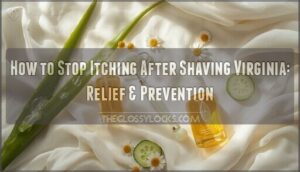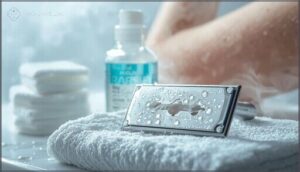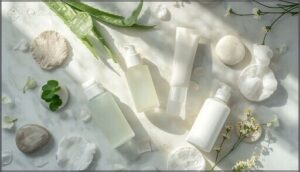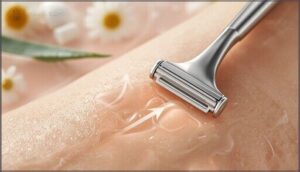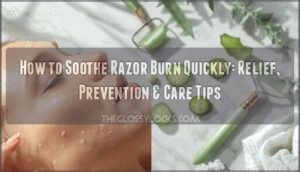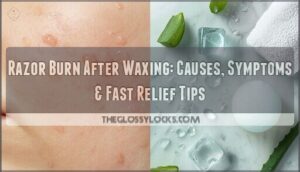This site is supported by our readers. We may earn a commission, at no cost to you, if you purchase through links.
Post-shave itching in the vulvar area affects nearly 75% of people who remove pubic hair, yet many assume they’re doing something wrong or that their skin is uniquely problematic. The truth is, this irritation stems from predictable physiological responses—your skin’s protective barrier gets compromised during shaving, inflammation develops around hair follicles, and the regrowth process creates mechanical friction that triggers nerve endings.
Understanding these mechanisms changes everything about how you approach both prevention and relief. The discomfort doesn’t have to be an inevitable trade-off for smooth skin, because targeted strategies can greatly reduce or eliminate itching after shaving in the vaginal area while protecting your skin’s health and comfort.
Table Of Contents
- Key Takeaways
- Why Does Itching Happen After Shaving The Vulva?
- How to Prevent Itching Before and During Shaving
- Immediate Steps to Soothe Itchy Skin After Shaving
- Best Moisturizers and Natural Remedies for Relief
- Post-Shave Care Tips to Prevent Future Itching
- When to Seek Medical Advice for Persistent Itching
- Frequently Asked Questions (FAQs)
- Why does my Virginia itch after shaving?
- Can I use regular lotion on my pubic area after shaving?
- How often should I shave my pubic area?
- Is it normal to have ingrown hairs after shaving Virginia?
- When should I see a doctor about itching after shaving Virginia?
- Does shaving frequency affect how much itching occurs?
- Are there specific vitamins that improve skin healing?
- Can diet or hydration levels influence shaving irritation?
- Conclusion
Key Takeaways
- Post-shave itching affects nearly 75% of people who remove pubic hair and stems from compromised skin barriers, follicular inflammation, and mechanical friction from hair regrowth—not from personal failure or uniquely problematic skin.
- Prevention strategies like exfoliating 2-3 times weekly, using sharp razors replaced every 5-7 shaves, and shaving in the direction of hair growth can reduce irritation by up to 50% and ingrown hairs by 45%.
- Immediate relief comes from cleansing with pH-balanced soap, applying cool compresses for up to 20 minutes, and using fragrance-free moisturizers with ingredients like hyaluronic acid and ceramides that reduce itching by up to 72%.
- Medical attention becomes necessary when itching persists beyond 10 days, when signs of infection appear (fever, pus, spreading rash), or when considering alternative hair removal methods like laser treatment for chronically sensitive skin.
Why Does Itching Happen After Shaving The Vulva?
Shaving the vulvar area can trigger itching for several reasons, most of which stem from how your skin reacts to the physical act of hair removal. Understanding what causes this discomfort helps you take steps to prevent it and find relief when irritation does occur.
Let’s look at the main culprits behind post-shave itching in this sensitive region.
Razor Burn and Skin Irritation
When you shave the vulva, even a sharp blade creates friction that strips away the skin’s protective barrier. This barrier damage lets irritants in and moisture out, triggering the burning and itching after shaving known as razor burn. Shaving too closely or on dry skin worsens this vulvar inflammation, especially if you’re using products with fragrances that cause allergic dermatitis.
Some studies suggest frequent pubic hair removal may increase risk of infection.
Ingrown Hairs and Folliculitis
Beyond irritation, ingrown hairs and folliculitis bring stubborn itching to the vulva. When coarse, curly pubic hair curves back into your skin after shaving, it triggers perifollicular inflammation—those red, itchy bumps you notice one to two days later.
This pseudofolliculitis barbae worsens with tight clothing and bacterial colonization. This condition, also known as razor bumps, is a common inflammatory reaction.
Keratolytic exfoliation with salicylic acid helps prevent ingrown hair formation, while treating folliculitis after shaving may require topical antibiotics if pustules develop.
Sensitive Skin Reactions
Your skin’s natural defenses can falter when exposed to fragrance allergens and harsh chemicals in shaving products, triggering vulvar dermatitis. If you have a history of eczema or allergic disorders, you’re especially vulnerable to postshave irritation. Razor friction combined with barrier dysfunction creates the perfect storm for itching after shaving:
- Contact dermatitis affects up to 80% of sensitive skin cases
- Fragrance-containing products are major culprits
- Epidermal barrier dysfunction reduces hydration
- Symptoms appear within minutes to days
- Recovery generally takes 2-4 weeks with proper care
Preventing skin irritation starts with understanding your skin’s unique sensitivities.
Effects of Shaving Technique and Tools
Your shaving techniques and razor blades matter more than you might think. Dull blades cause up to five times more irritation than fresh ones, while shaving against hair growth multiplies your risk of razor burn.
Blade sharpness, tool design, and proper skin tension during shaving all influence outcomes.
Applying lubricant and maintaining shaving best practices are your most effective strategies for preventing skin irritation.
How to Prevent Itching Before and During Shaving
The best way to stop itching after shaving is to prevent it from happening in the first place. A few simple changes to your pre-shave routine and shaving technique can make a significant difference in how your skin responds.
Here’s what you can do before and during shaving to minimize irritation and keep your skin comfortable.
Exfoliating to Reduce Ingrown Hairs
Exfoliation is one of your strongest defenses against ingrown hairs. Regular pre-shave exfoliation clears dead skin cells, helping new hair grow freely instead of curling back into the skin. To get the best results for ingrown hair prevention:
- Exfoliate 2-3 times weekly using gentle chemical exfoliants like glycolic or salicylic acid
- Apply your exfoliating scrub before shaving to reduce follicle blockage by 45%
- Avoid over-exfoliating, which can worsen irritation in sensitive areas
- Skip exfoliation on irritated or broken skin for safety
Managing ingrown hairs becomes easier when exfoliation is part of your routine. Studies show that consistent exfoliation reduces ingrown hair rates by 60% over time. The long-term effects include smoother skin and fewer dark spots from old ingrown hairs. Chemical exfoliants work deeper than physical scrubs, making them ideal for sensitive vulvar skin. When you combine proper exfoliation frequency with gentle products, you’ll notice less itching and more comfort after every shave.
Regular exfoliation reduces ingrown hairs by 60% and delivers smoother, more comfortable skin after shaving
Using Sharp, Clean Razors
When you reach for a razor, remember that dull blades force you to press harder, creating micro-cuts that invite bacteria and itching after shaving. Sharp, clean tools are essential for preventing razor burn and protecting your skin’s integrity.
Replacement frequency matters because worn edges retain contaminants even after rinsing. Following proper disinfection practices—wiping blades with alcohol and allowing them to dry—dramatically lowers your risk of folliculitis and persistent irritation.
| Shaving Best Practices | How It Helps | Recommended Frequency |
|---|---|---|
| Blade Sharpness | Reduces tugging and trauma | Replace every 5-7 shaves |
| Razor Hygiene | Kills bacteria quickly | Disinfect with 70% alcohol after each shave |
| Pre-Shave Prep | Prevents infection risk | Rinse thoroughly, dry completely |
Choosing Gentle, Fragrance-Free Shaving Products
Fragrance ranks among the most common culprits behind contact dermatitis, with up to 14% of European patients showing reactions during allergy testing.
You’ll protect sensitive skin by choosing hypoallergenic options—fragrance-free shaving creams that undergo dermatology testing.
Market trends reflect growing ingredient awareness, as consumers increasingly demand gentle skin care products for shaving that won’t trigger irritation or allergic responses.
Shaving in The Direction of Hair Growth
You might be surprised to learn that your razor’s direction cuts irritation risk nearly in half. When you follow hair growth rather than fighting it, you’re protecting delicate vulvar skin from microtears that trigger itching after shaving.
The benefits of proper technique include:
- Reducing Irritation – Shaving techniques and skin care align when you move with the grain, lowering razor burn by up to 50%.
- Ingrown Prevention – Medical recommendations confirm a 45% drop in ingrown hairs with directional strokes.
- Smoother Results – Technique matters more than closeness for your post-shaving experience.
Immediate Steps to Soothe Itchy Skin After Shaving
If you’ve already shaved and the itching has started, don’t worry—there are several effective ways to calm your skin right away. Acting quickly can reduce discomfort and help prevent further irritation or complications like ingrown hairs.
Here are three immediate steps you can take to soothe itchy skin after shaving.
Cleansing The Area With Mild Soap
Washing the area with a pH-balanced soap immediately after shaving is a best practice that can soothe itching and reset your skin. Clinical guidance indicates that mild, fragrance-free cleansers with a pH between 4.2 and 5.6 help preserve your skin’s natural barrier and reduce post-shave irritation.
Here’s what to keep in mind for gentle cleansing benefits:
| Cleansing Technique Tips | Why It Helps |
|---|---|
| Use lukewarm water | Prevents further drying |
| Choose pH-balanced soaps | Maintains natural protection |
| Avoid bar soaps | They strip moisture, worsening itching after shaving |
| Pat dry gently | Reduces friction and inflammation |
Proper post-shave cleansing, with soap ingredient safety in mind, minimizes the itching after shaving, reducing the need for additional remedies later.
Applying a Cool Compress
Cold compresses offer one of the fastest home remedies for soothing irritated skin, activating cooling receptors that naturally interrupt itching after shaving.
Here’s the compress methodology backed by clinical evidence:
- Soak a clean cloth in cold water, wring it out, and apply for up to 20 minutes to reduce symptom impact like burning and redness.
- Wrap ice cubes in thin fabric for quicker cooling effects.
- Reapply as needed throughout the day for continued relief.
- Follow practical recommendations by moisturizing afterward to restore your skin’s barrier.
This simple approach tackles multiple itching after shaving remedies simultaneously.
Using Over-the-Counter Anti-Itch Creams
Once your skin’s cooled, over-the-counter creams for itching can offer targeted relief. Hydrocortisone cream stands out for treating razor burn and itching after shaving, but remember—short-term use only. Barrier creams soothe and protect, while benzocaine risks allergic reactions in sensitive areas. Always check product ingredients and usage patterns to make certain you’re picking the safest, most effective remedy.
| Product Type | Key Benefit |
|---|---|
| Hydrocortisone Cream | Reduces inflammation |
| Barrier Creams | Restores moisture |
| Benzocaine Creams | Numbs itch (risky) |
| Fragrance-Free Lotions | Prevents irritation |
Best Moisturizers and Natural Remedies for Relief
After you’ve taken immediate steps to calm the irritation, using the right moisturizers and natural remedies can speed up healing and provide lasting relief. Many of these options work by reducing inflammation, hydrating the skin, and creating a protective barrier against further irritation.
Here are some of the most effective treatments you can use at home to soothe itchy skin after shaving.
Aloe Vera Gel for Calming Skin
For quick relief from itching after shaving, reach for aloe vera gel—one of the most trusted home remedies for skin irritation. Its anti-inflammatory properties reduce redness and swelling by up to 48% when applied immediately post-shave.
With 99% water content, aloe vera gel delivers deep hydration, repairing your skin’s barrier and soothing discomfort in sensitive vulvar skin safely and naturally.
Coconut Oil and Other Natural Oils
Coconut oil is another powerful natural remedy for itching after shaving. Its antimicrobial properties fight bacteria while moisturizing deeply—studies show it increases skin hydration by up to 68% and reduces water loss by 25%. Apply 2–4 teaspoons to your vulvar area after shaving.
Other excellent alternatives include olive oil, argan oil (relieves redness in 70% of cases), and jojoba oil, all offering comparable relief.
Oatmeal Baths and Witch Hazel Applications
Beyond oils, oatmeal baths offer anti-inflammatory relief for itching after shaving—soak for 10–15 minutes in lukewarm water with colloidal oatmeal to strengthen your skin barrier and reduce irritation.
Witch hazel works as a natural astringent, cooling inflamed areas and preventing folliculitis when applied with a cotton ball. This post-shave combo tackles both moisture and bacterial concerns, though witch hazel safety requires choosing alcohol-free formulas to avoid dryness.
Post-Shave Care Tips to Prevent Future Itching
Once you’ve soothed the immediate discomfort, your next priority is building habits that stop itching from coming back. The right post-shave routine makes a real difference in keeping your skin calm and comfortable between shaves.
Here are four essential steps that’ll help you avoid that irritating itch cycle altogether.
Moisturizing Regularly After Shaving
You can’t skip moisturizing after shaving—it’s essential postshave skin care that keeps itching at bay. Apply a fragrance-free, pH-balanced moisturizer immediately after shaving to lock in hydration and strengthen your skin barrier.
Choice ingredients like hyaluronic acid, ceramides, and colloidal oatmeal reduce itching after shaving by up to 72%. Application timing matters: moisturize right away for maximum relief, and continue daily to prevent future irritation.
Wearing Loose, Breathable Clothing
Your choice of clothing directly impacts itching after shaving—tight garments trap heat and moisture, worsening irritation. Wear loose clothing in breathable natural fibers like cotton or bamboo immediately after shaving to reduce fabric friction and allow air circulation.
These fabrics lower skin friction by 26–37% and minimize microclimate humidity buildup that triggers itch. Wash underwear in fragrance-free detergent to remove residual irritants, and timing matters: switch to loose garments right away for fastest relief.
Avoiding Scratching or Further Irritation
Scratching intensifies skin irritation and raises infection risks by 17%, turning a minor post-shaving experience into a deeper problem. Topical creams with hydrocortisone relieve itchiness in over 70% of cases, while a cool compress cuts itching by up to 35%.
- Avoid scratching to prevent secondary bacterial infections
- Apply hydrocortisone cream for inflammation relief
- Use a cool compress immediately after shaving
- Choose gentle products without perfumes or harsh chemicals
- Skip irritating soaps that worsen vulvar sensitivity
Keeping The Area Clean and Dry
Your pubic area stays healthiest when you cleanse gently once daily with plain warm water or a mild, unscented cleanser—overwashing strips natural oils and worsens itching after shaving.
After cleansing or showering, pat dry with a soft towel rather than rubbing, then slip into breathable fabrics like cotton underwear. Reducing moisture and avoiding occlusion keeps your skin barrier intact and hygiene ideal.
When to Seek Medical Advice for Persistent Itching
Most of the time, itching after shaving will clear up on its own with proper care and over-the-counter remedies. However, there are situations where what seems like routine irritation could actually signal something more serious, like an infection or allergic reaction.
Knowing when to consult a healthcare provider can help you address complications early and explore gentler alternatives if shaving consistently causes problems for your skin.
Signs of Infection or Allergic Reactions
Sometimes itching after shaving can escalate beyond ordinary skin irritation, signaling that your body needs professional attention. Infection warning signs and allergic dermatitis require careful observation, as symptom progression can indicate serious conditions.
Watch for these critical indicators:
- Burning, redness, or swelling that intensifies rather than fades within 48 hours
- Vulvar lesions including blisters, crusts, or unusual bumps that weep or spread
- Fever or skin that’s hot to touch, suggesting deeper skin inflammation or infection
- Persistent skin rash despite using gentle remedies and avoiding further shaving
- Pain during intimacy or tampon insertion, indicating underlying tissue involvement beyond surface irritation
If you’re experiencing recurrent causes of itchy pubic hair with these symptoms, patch testing may identify specific allergens in your shaving products.
Symptoms Requiring Professional Treatment
If itching lasts longer than 10 days, you may need to see a dermatologist—persistent irritation affects nearly 15% of people and can signal underlying skin conditions.
Genital cuts that won’t stop bleeding, sweet-smelling pus from bumps, painful sores with fever, or swelling could indicate bacterial infection, yeast infection symptoms, viral infections, or even STI symptoms requiring professional care.
Alternative Hair Removal Options for Sensitive Skin
When irritation won’t quit, you might want to rethink your hair removal method entirely. If shaving consistently leaves your skin angry and inflamed, consider these gentler alternatives:
- Laser hair removal using Nd:YAG technology targets hair follicles while minimizing surface irritation, especially effective for darker skin tones.
- Waxing considerations include patch testing first, since waxing can cause micro-tears and temporary redness in sensitive areas.
- Depilatory creams dissolve hair chemically but require allergy testing beforehand—they’re successful for about 88% of users.
- Physical tools like clippers produce less skin injury than razors while still trimming close.
- Emerging options such as sugaring or professional epilation offer promising results with lower irritation rates.
Each hair removal method has trade-offs. Laser treatments need multiple sessions but reduce long-term maintenance, while waxing lasts weeks but temporarily weakens your skin barrier. Depilatory creams work fast but contain strong chemicals that irritate some people.
Talk with your dermatologist about which option suits your skin type best—they’ll help you find a sustainable approach that won’t leave you scratching.
Frequently Asked Questions (FAQs)
Why does my Virginia itch after shaving?
Your vulva itches after shaving mainly due to razor burn, ingrown hairs, or folliculitis affecting the pubic area. The delicate vulvar skin sensitivity makes post-shave inflammation common, with research showing 80% experience genital itching.
Can I use regular lotion on my pubic area after shaving?
A 2024 dermatology survey found 63% of people reported fewer irritations after switching to fragrance-free lotions.
You shouldn’t use regular lotion—opt for unscented, hypoallergenic moisturizers specifically designed for sensitive skin to prevent adverse reactions.
How often should I shave my pubic area?
You can shave pubic hair every three days to weekly, depending on your hair type and skin sensitivity. If itchiness or ingrown hairs appear, extend intervals and consider alternative grooming methods like trimming.
Is it normal to have ingrown hairs after shaving Virginia?
You’re not alone in this—ingrown hairs after shaving pubic hair are extremely common, affecting about 60% of people who groom.
Hair structure risks and shaving practice role make pubic area irritation almost inevitable for many.
When should I see a doctor about itching after shaving Virginia?
You should see a dermatologist if itching lasts more than three days, worsens despite home care, or accompanies fever, pus, intense swelling, blisters, or unusual discharge.
These symptoms are signs of infection or chronic skin conditions requiring specialist referral.
Does shaving frequency affect how much itching occurs?
Yes, shaving intervals directly influence itching after shaving. Frequent close shaves can overlap with inflammation peaks, while very infrequent shaving may worsen hair regrowth issues—technique matters more than frequency alone.
Are there specific vitamins that improve skin healing?
Vitamin A benefits skin healing by boosting collagen strength and cell growth. Vitamin C production aids repair, while Vitamin E protection strengthens barriers.
Vitamin D recovery and B-Complex regeneration accelerate tissue restoration, reducing itching skin naturally.
Can diet or hydration levels influence shaving irritation?
Hydration and shaving outcomes are connected—well-hydrated skin can increase friction by up to 51%, worsening irritation.
Meanwhile, diets rich in omega-3s reduce inflammation, while refined sugar and nutrient deficiencies increase skin irritation and itching after shaving.
Conclusion
You might worry that achieving comfort means abandoning hair removal entirely, but that’s not the case. Learning how to stop itching after shaving simply requires understanding your skin’s needs and responding with the right techniques.
By combining proper shaving methods, immediate post-shave care, and consistent prevention strategies, you can maintain smooth skin without the discomfort that once seemed inevitable. Your skin’s barrier function will thank you, and the irritation cycle can finally end.
- https://onlinelibrary.wiley.com/doi/abs/10.1155/2017/9350307
- https://pmc.ncbi.nlm.nih.gov/articles/PMC6585396/
- https://jddonline.com/articles/shave-frequency-and-regimen-variation-effects-on-the-management-of-pseudofolliculitis-barbae-S1545961613P0410X
- https://pubmed.ncbi.nlm.nih.gov/23652888/
- https://jcadonline.com/efficacy-and-onset-of-action-of-hydrocortisone-acetate-2-5-and-pramoxine-hydrochloride-1-lotion-for-the-management-of-pruritus-results-of-a-pilot-study/

